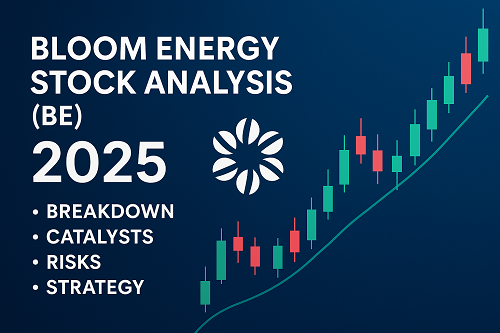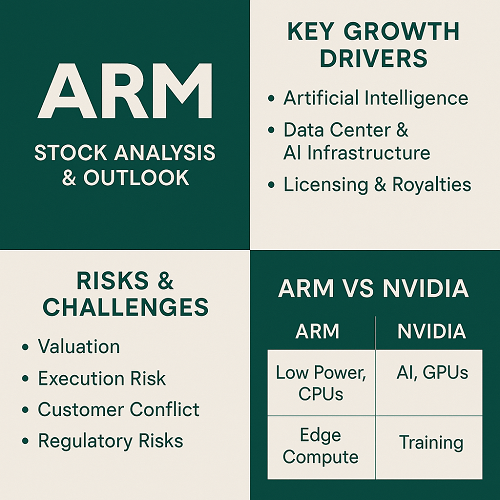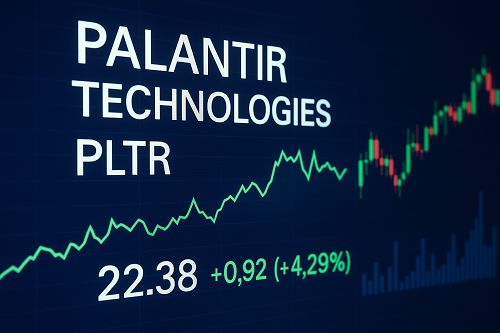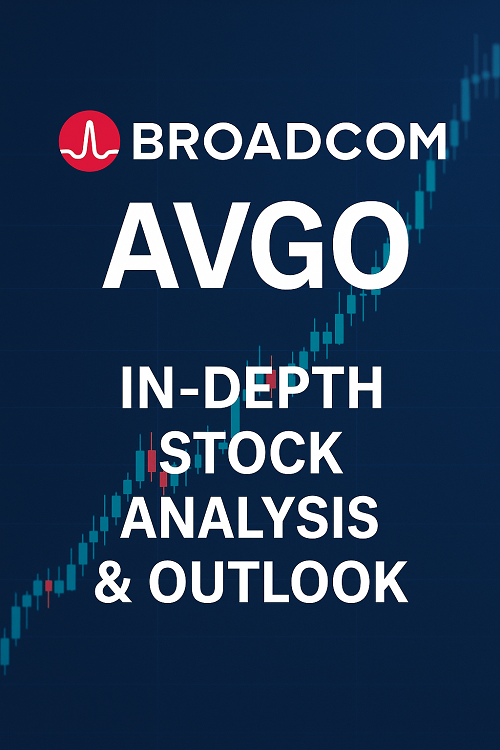Bloom Energy Corporation (BE), traded on the NYSE under the ticker symbol NYSE BE, is a U.S.-based clean-technology company that designs, manufactures and markets solid oxide fuel cell (SOFC) systems for distributed onsite power generation, as well as hydrogen production equipment.
Business Model Highlights
- Its flagship product, the Bloom Energy Server (also called Bloom Box), converts fuels (natural gas, biogas, hydrogen) into electricity through an electrochemical process rather than combustion.
- Enables on-site power generation for industrial, commercial, data-center and microgrid applications — thereby bypassing some traditional grid constraints.
- Headquarters: San Jose, California. Founded 2001 (originally Ion America), re-branded to Bloom Energy.
Technological Edge
- SOFC technology: higher efficiency than many conventional generation methods; ability to deploy close to load centres (important for latency-sensitive uses e.g. data centers).
- Diversification into hydrogen/electrolyzer business: adding another dimension in clean-energy transition.
Why It Matters for Investors
The intersection of distributed clean power + data-center demand + hydrogen infrastructure gives Bloom a potentially heavy addressable market — beyond just “another green energy play.”
Industry & Market Context
Understanding the backdrop is critical for anticipating BE’s future.
Clean Energy / Fuel-Cells
- Fuel cell companies remain a niche but evolving part of the broader clean-energy ecosystem.
- SOFCs offer advantages (efficiency, modularity) but face challenges (manufacturing scale, cost structure).
Data Center / AI Power Demand
- One of the key secular themes for BE: the explosion of AI and cloud infrastructure has driven major growth in data-center build-out, which in turn demands reliable, on-site power.
- Traditional grid power and even new renewables sometimes cannot scale or deploy fast enough to meet data-center needs — offering an opportunity for fast-deploy technologies like Bloom’s.
Decarbonization & Onsite Generation
- Corporations increasingly want resilient, low-carbon power — not just buying green credits but physical power generation behind their load.
- On-site generation bypasses some grid interconnection delays, one of the attractive features of Bloom’s proposition.
In short: the company stands at a convergence of multiple growth vectors: clean power, decentralised generation, and AI-data-center infrastructure.
Recent Performance: What’s Driving the Surge
BE has seen a dramatic move in 2025.
Rally & Momentum
- According to one source: shares are up ~300% in 2025 as of early October, driven by data-center demand tailwinds.
- Recent major announcements help explain the momentum: e.g., a partnership with Brookfield Asset Management to deploy ~$5 billion in projects for AI data-centers.
- Analysts upgraded or raised targets on the stock due to this repositioning.
Sentiment Snapshot
- Analyst ratings vary: some see a strong buy, others remain cautious. For example, 24 analysts have an average price-target ~US$61.70 (which implies downside from current levels in some cases).
- Technical indicators: the stock’s IBD Composite Rating was upgraded to 96, placing it among the top 4% of stocks for performance/strength.
Thus, both fundamental catalysts and sentiment shifts are contributing to BE’s recent surge.
Financials, Valuation & Analyst Sentiment
This section digs into the numbers and the market’s view.
Key Financials
- From the company website: The platform supports electricity and hydrogen generation.
- FY2024 revenue reported ~US$1.47 billion.
- According to Craft.co: Q2 2025 revenue ~US$401.2 million, gross profit US$107.1 million, net income negative ~US$42.2 million.
- So, growth is present, but profitability remains a challenge.
Valuation & Price Targets
- Analyst consensus (MarketBeat) for 12-month price target: US$61.70 (implying ~-44.6% from current levels) with a “Hold” rating.
- StockAnalysis shows consensus price target ~US$65.95 (~-30% downside) and average rating “Hold”.
- But this does not fully reflect the recent upside/partnerships — many analyst models may still be lagging the new growth narrative.
Market Capitalisation & Sentiment
- Market cap: As of early Oct 2025, estimates around US$20 billion.
- Sentiment: Mixed, but leaning bullish due to new strategic deals.
Bottom line: The company is expensive relative to traditional valuation metrics, with profitability still to scale — but the narrative and growth potential may justify a premium if execution is strong.
Key Catalysts & Growth Drivers
Here are the major levers that could drive BE’s future.
Data Center & AI Infrastructure
- The Brookfield deal (~US$5 billion) positions Bloom as a power-provider in the AI data-center boom.
- The speed of deployment (Bloom claims systems can be shipped and operational within ~90 days) gives it an advantage where grid or large utility scale can’t keep up.
Manufacturing Scale & Cost Improvements
- Manufacturing scale is critical for fuel-cells. Any meaningful improvement in unit costs or output has large leverage to margin expansion.
- Government subsidies/tax credits: E.g., $75 million tax credit for its Fremont manufacturing plant.
- Long-term target: gross margins ~27-30%.
Hydrogen & Clean Power Transition
- Bloom’s entry into electrolyzers/hydrogen gives them another addressable market.
- On-site generation for commercial & industrial (C&I) customers is gaining traction as companies look for resiliency, decarbonisation and cost control.
Strategic Partnerships & Customers
- Partnering with major customers (e.g., cloud providers, data centers) provides both revenue credibility and validation of the technology.
- Such contracts often carry service or recurring-revenue models which can boost margin stability.
Risks & Challenges to Watch
Every opportunity comes with corresponding risks — and BE has several.
Execution Risk & Manufacturing
- Fuel-cell manufacturing is capital-intensive, with risks of delays, cost overruns, or yield problems.
- If scale-up is slower than expected, margins could suffer.
Profitability and Cash Flow
- Despite strong growth, the company is still not reliably profitable. Q2 2025 showed a net loss.
- If cash-burn remains high and growth doesn’t translate to positive EBITDA, this could dampen investor enthusiasm.
Competition & Technology Risk
- Other forms of clean power generation (solar + batteries, gas turbines with carbon capture, other fuel-cell firms) could compete on cost or speed.
- Fuel-cells still carry more “technology risk” than more commoditised alternatives.
Valuation Risk
- With many large gains already in the share price, future upside may require exceptional execution. Analyst targets suggest limited upside or even downside from current levels under some scenarios.
Macro / Grid / Regulatory Risks
- Changes in government incentives / tax credits could hurt the business model.
- Grid interconnection changes, utility rate changes or regulatory headwinds could impact economics.
Trading & Investment Strategy Framework
Here’s how one might approach BE from both a trading perspective and a longer-term investment angle.
Trading Approach
- Catalyst-driven trades: Monitor for partnership announcements, order wins, quarter earnings surprises. For example, the Brookfield announcement triggered a strong move.
- Volatility strategy: Because the stock has moved significantly, it may have elevated volatility — suitable for swing trades or option strategies rather than “buy & hold” at current levels.
- Entry / pullback zones: If you’re trading, look for consolidation or pullback after large rallies to manage risk.
Investment / Buy-and-Hold Approach
- Position sizing: Given the elevated valuation and execution risk, one might allocate a smaller portion of the portfolio to BE.
- Time horizon: If investing, let this be a 3-5 year thesis — to allow manufacturing scale and contracts to mature.
- Milestone tracking: Key milestones to validate the thesis: (a) profitability improvement, (b) margin expansion, (c) large-scale enterprise contracts announced/fulfilled, (d) reduction in unit costs.
- Re-assessment triggers: If major partnerships fail, margins miss targets, or subsidy/tax-credit regime deteriorates — re-consider the position.
Example Strategy
- Entry around/consolidation near ~US$90-100 if the pullback sets in, with stop-loss, because upside from current price may be modest unless major upside surprise.
- Hold target may be +50-100% over a few years if Bloom executes strongly and converts growth into profits — but might also plateau or correct if execution disappoints.
Outlook & Verdict
Verdict: Bloom Energy represents a compelling story: clean-energy technology, strong alignment with the AI/data-center boom, and a differentiated business model (onsite fuel cells + hydrogen). However, it also carries substantial execution and valuation risk.
Short-Term (12-18 months): Given current valuation and analyst targets, the stock appears to have limited upside in the near term unless there is a major positive surprise (e.g., a multi-billion contract win, profitability beat).
Long-Term (3-5 years): If Bloom can scale manufacturing, expand margins, deliver on major contracts, and convert business momentum into reliable profits, it could be a standout. But the path is not guaranteed.
Recommendation:
- For traders, consider Bloom for catalyst-driven plays but manage risk tightly (volatile, elevated valuation).
- For investors, if you believe strongly in the clean-power + AI infrastructure story and are comfortable with risk, a smaller allocation may make sense for a multi-year play.
- For those risk-averse or looking for more immediate upside, this might not be the optimal time—better wait for consolidation or a pullback.
Key Take-aways
- Bloom Energy is at the intersection of clean power, distributed generation, hydrogen and AI-data-center demand.
- Strong recent momentum, but profitability remains immature and valuation is stretched.
- Future success hinges on manufacturing scale, cost control, major contracts and margin expansion.
- Strategy should be aligned with your time horizon, risk tolerance and the level of conviction you have in the execution.





 XAUT-USD
XAUT-USD  AMD
AMD  MARA
MARA  SHOP
SHOP  BULL
BULL  CL=F
CL=F